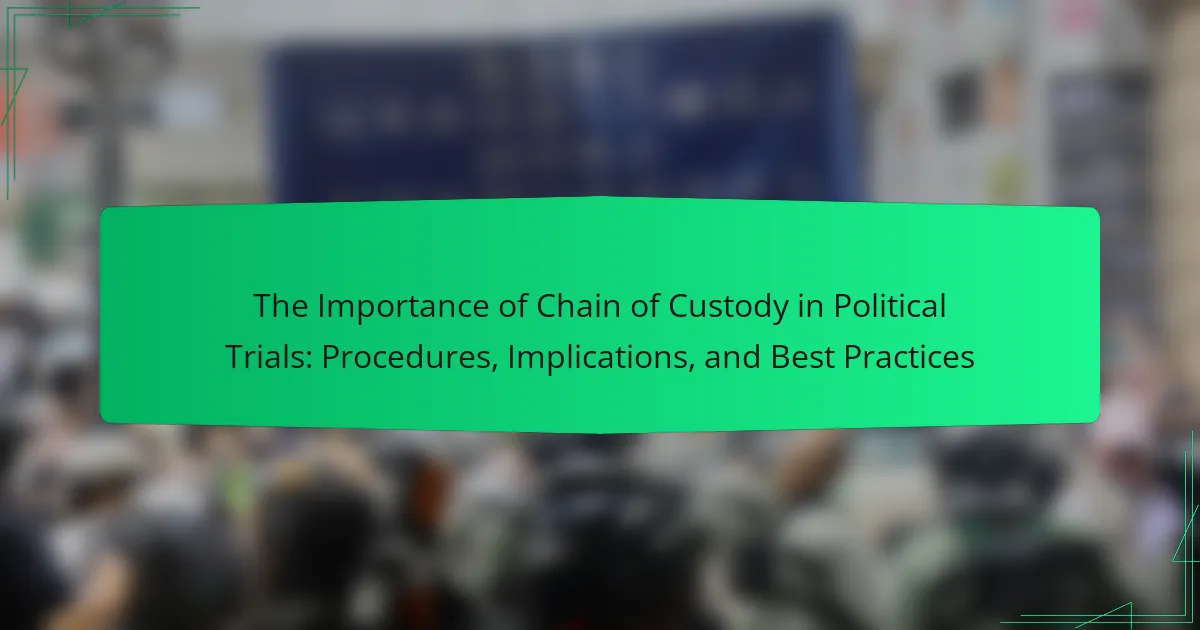The chain of custody is a critical process in political trials, ensuring the integrity and authenticity of evidence from collection to presentation in court. This article examines the procedures and legal standards involved in maintaining a proper chain of custody, highlighting the implications of evidence mishandling and the potential consequences for trial outcomes. It emphasizes the importance of thorough documentation and adherence to protocols, as any break in the chain can lead to evidence being deemed inadmissible, ultimately affecting the credibility of a case. Key examples, such as the case of *State v. Williams*, illustrate the significance of maintaining a reliable chain of custody to uphold justice and accountability in legal proceedings.

What is the significance of chain of custody in political trials?
The chain of custody is crucial in political trials as it ensures the integrity of evidence. This process documents the handling of evidence from collection to presentation in court. Proper chain of custody prevents tampering or contamination of evidence. It establishes a clear link between the evidence and the case. Courts rely on this documentation to validate the authenticity of evidence. A break in the chain can lead to evidence being deemed inadmissible. This can significantly impact the outcome of a trial. Therefore, maintaining a proper chain of custody is essential for justice and accountability in political trials.
How does the chain of custody process work in political trials?
The chain of custody process in political trials ensures the integrity of evidence. It begins with the collection of evidence by law enforcement or investigators. Each item collected must be documented meticulously. This documentation includes details about who collected the evidence and when it was collected. The evidence is then secured in a tamper-proof container. This container is labeled with unique identifiers to track its handling. Each transfer of evidence must be logged to maintain accountability. This log includes names of individuals who handled the evidence and the dates of each transfer. Maintaining a clear chain of custody prevents challenges to the evidence’s authenticity in court.
What are the key steps involved in establishing a chain of custody?
The key steps involved in establishing a chain of custody include identifying the evidence, documenting its collection, and securing it. First, personnel must identify the evidence relevant to the case. Next, they should document the collection process, including time, date, and location. This documentation must include the names of individuals who collected the evidence. After collection, the evidence must be securely stored to prevent tampering. Each transfer of evidence should be recorded, noting who handled it and when. Finally, maintaining a clear and detailed log throughout the process ensures the integrity of the chain of custody. These steps are crucial to uphold the legal standards required in political trials.
Who is responsible for maintaining the chain of custody?
Law enforcement agencies are primarily responsible for maintaining the chain of custody. This responsibility ensures that evidence is collected, preserved, and documented properly. Each agency involved must follow strict protocols to prevent contamination or tampering. Additionally, legal professionals, such as prosecutors and defense attorneys, play a role in overseeing the integrity of the chain. Their involvement is crucial during trials to validate the evidence presented. Proper training and adherence to established procedures are essential for all parties. Failure to maintain the chain can lead to evidence being deemed inadmissible in court. This principle is vital in political trials where the stakes are high.
Why is chain of custody critical for the integrity of political trials?
Chain of custody is critical for the integrity of political trials because it ensures the authenticity and reliability of evidence presented. Maintaining a documented chain of custody prevents tampering or alteration of evidence. This process involves tracking the handling of evidence from collection to presentation in court. Each transfer of evidence must be recorded to establish accountability. Without a clear chain of custody, the admissibility of evidence can be challenged. Historical cases show that broken chains of custody have led to mistrials. For instance, in political trials, the credibility of evidence can directly impact verdicts. Therefore, a robust chain of custody is essential for upholding justice in political contexts.
How does chain of custody impact the admissibility of evidence?
Chain of custody significantly impacts the admissibility of evidence in legal proceedings. It ensures that evidence remains untampered and reliable from collection to presentation in court. A documented chain of custody provides a clear record of who handled the evidence and how it was stored. This documentation helps to establish the integrity of the evidence. If the chain is broken or not properly documented, the evidence may be deemed inadmissible. Courts require this reliability to prevent wrongful convictions or dismissals. Historical cases demonstrate that weak chains of custody have led to overturned verdicts. Therefore, maintaining a strict chain of custody is crucial for the legal process.
What are the consequences of a compromised chain of custody?
A compromised chain of custody can lead to the dismissal of evidence. This undermines the integrity of the judicial process. When evidence is deemed inadmissible, it weakens the prosecution’s case. It can also result in wrongful convictions or acquittals. The credibility of law enforcement may be questioned. Additionally, it can lead to public distrust in the legal system. Courts may impose sanctions on parties responsible for the breach. These consequences highlight the necessity of maintaining a secure chain of custody.
What best practices should be followed for effective chain of custody?
Maintain detailed documentation of all evidence. This includes time, date, and individuals involved. Use tamper-evident seals for physical evidence. This ensures that any unauthorized access is detectable. Train personnel in proper handling procedures. Proper training reduces the risk of contamination or loss. Implement a secure storage system for evidence. This protects items from damage or tampering. Conduct regular audits of evidence management. Audits help identify any discrepancies in the chain of custody. Follow established protocols for transferring evidence. Consistency in procedures ensures reliability in legal contexts.
How can technology enhance the chain of custody process?
Technology can enhance the chain of custody process by improving tracking, documentation, and security. Digital systems enable real-time monitoring of evidence. These systems can log every interaction with the evidence, ensuring accurate records. Blockchain technology offers immutable records, preventing tampering. Electronic signatures authenticate the transfer of custody. Mobile applications allow instant updates and notifications. RFID tags can track physical evidence locations automatically. These advancements reduce human error and increase accountability. A study by the National Institute of Standards and Technology highlights the importance of technology in maintaining integrity in evidence handling.
What training is necessary for personnel involved in maintaining chain of custody?
Personnel involved in maintaining chain of custody require specialized training in evidence handling. This training includes understanding legal standards for evidence preservation. Personnel must learn proper documentation techniques for evidence collection. Training also covers the importance of maintaining a clear chain of custody log. Personnel should be educated on the potential legal implications of mishandling evidence. Familiarity with relevant laws and regulations is essential. Additionally, practical exercises in evidence collection and preservation are beneficial. Regular refresher courses can help ensure ongoing compliance and knowledge retention.

What are the implications of chain of custody on trial outcomes?
Chain of custody significantly impacts trial outcomes. It ensures that evidence is preserved and remains untampered. A break in the chain can lead to questions about the evidence’s integrity. This can result in the exclusion of evidence in court. Courts often require strict adherence to chain of custody protocols. Failure to comply can weaken a case’s credibility. For instance, the case of *State v. Williams* highlighted how evidence mishandling led to a mistrial. Proper chain of custody reinforces the reliability of evidence presented. Thus, maintaining it is crucial for achieving just trial outcomes.
How does chain of custody influence public perception of political trials?
Chain of custody significantly influences public perception of political trials by establishing the integrity of evidence. A well-documented chain of custody assures the public that evidence has been properly handled and preserved. This transparency fosters trust in the judicial process. Conversely, any gaps or inconsistencies in the chain can lead to skepticism about the trial’s fairness. Historical examples, such as the Watergate scandal, illustrate how evidence handling affected public opinion. In that case, the perceived mishandling of evidence raised doubts about the legitimacy of the proceedings. Therefore, maintaining a clear chain of custody is essential for upholding public confidence in political trials.
What role does transparency play in the chain of custody?
Transparency is crucial in the chain of custody as it ensures accountability and integrity. It allows all parties involved to verify the handling of evidence. Clear documentation of each transfer and storage step is essential. This documentation prevents tampering or contamination of evidence. Transparency fosters trust among stakeholders, including the court and the public. It also facilitates audits and reviews of the custody process. Studies show that transparent practices reduce the risk of evidence challenges in legal proceedings. Ultimately, transparency strengthens the overall credibility of the judicial process.
How can breaches in chain of custody affect legal precedents?
Breaches in chain of custody can significantly undermine legal precedents. Such breaches may lead to the dismissal of evidence in court. Courts rely on the integrity of evidence for fair trials. If evidence is compromised, its reliability is questioned. This can result in wrongful convictions or acquittals. Historical cases illustrate this impact. For instance, in the case of “State v. McGowan,” evidence was deemed inadmissible due to chain of custody issues. This precedent affects future cases by setting standards for evidence handling. Therefore, maintaining chain of custody is crucial for upholding legal integrity.
What are common challenges faced in maintaining chain of custody?
Common challenges in maintaining chain of custody include improper documentation, loss of evidence, and contamination. Improper documentation occurs when records are not accurately maintained or updated. Loss of evidence can happen due to inadequate storage or handling procedures. Contamination may arise from environmental factors or human error during evidence collection. These challenges compromise the integrity of evidence and can affect the outcome of trials. According to a study by the National Institute of Justice, 20% of evidence in criminal cases is mishandled, highlighting the significance of strict adherence to chain of custody protocols.
What factors contribute to the breakdown of chain of custody?
Factors that contribute to the breakdown of chain of custody include improper handling of evidence, lack of documentation, and unauthorized access. Improper handling can occur during collection, transportation, or storage. Lack of documentation leads to gaps in the evidence trail. Unauthorized access may result from insufficient security measures. Each of these factors can compromise the integrity of the evidence. Research indicates that these issues can lead to legal challenges and the dismissal of evidence in court. Maintaining strict protocols is essential to preserve chain of custody.
How can organizations mitigate risks associated with chain of custody?
Organizations can mitigate risks associated with chain of custody by implementing strict protocols. They should establish clear procedures for evidence handling. Training personnel on these procedures is essential. Regular audits can ensure compliance with protocols. Utilizing secure storage for evidence reduces the risk of tampering. Documenting every transfer of custody creates a reliable chain. Employing technology, such as barcoding, enhances tracking accuracy. These measures collectively strengthen the integrity of the chain of custody.

What are the legal standards for chain of custody in political trials?
The legal standards for chain of custody in political trials require that evidence is collected, preserved, and documented in a manner that maintains its integrity. This process starts with proper identification of the evidence by law enforcement or investigators. Each transfer of evidence must be recorded to show who handled it and when. Documentation includes logs, photographs, and witness statements. The goal is to establish a clear, traceable path from the collection of evidence to its presentation in court. Courts often require this to ensure that evidence has not been tampered with or altered. Failure to adhere to these standards can result in evidence being deemed inadmissible. This principle is rooted in the need for transparency and accountability in legal proceedings.
How do different jurisdictions define chain of custody requirements?
Different jurisdictions define chain of custody requirements through specific legal frameworks. These frameworks govern the handling, transfer, and documentation of evidence. In the United States, the Federal Rules of Evidence outline procedures for maintaining the integrity of evidence. Many states have adopted similar rules, emphasizing the need for detailed documentation. For example, California requires a clear log of evidence handling. In the UK, the Police and Criminal Evidence Act provides guidelines for evidence management. These regulations ensure that evidence remains untampered and admissible in court. Compliance with these requirements is crucial for upholding the justice system’s integrity.
What are the variations in chain of custody laws across states?
Chain of custody laws vary significantly across states. Each state has its own regulations governing the handling of evidence. For instance, some states require strict documentation at every transfer of evidence. Other states may allow for more lenient practices. Additionally, certain states mandate specific training for individuals handling evidence. Others do not have such requirements. Variations also exist in the admissibility of evidence based on chain of custody adherence. Courts in some states may dismiss evidence if the chain is broken. In contrast, other jurisdictions may consider the context of the break. These differences can impact legal outcomes in political trials. Understanding these variations is crucial for legal professionals.
How can legal professionals ensure compliance with chain of custody standards?
Legal professionals can ensure compliance with chain of custody standards by meticulously documenting every step of evidence handling. This includes recording who collected, handled, and transferred the evidence. They should use standardized forms to maintain a clear chain of custody log. Each entry must include dates, times, and signatures of individuals involved. Additionally, legal professionals should secure evidence in tamper-proof containers to prevent contamination. Regular training on chain of custody protocols is essential for all staff involved. Following these practices helps maintain the integrity of evidence in legal proceedings. Proper adherence to these standards is crucial for upholding the admissibility of evidence in court.
What are the future trends in chain of custody practices?
Future trends in chain of custody practices include increased use of digital technology and blockchain. These advancements enhance traceability and transparency in evidence handling. Digital tools streamline documentation and reduce human error. Blockchain provides an immutable ledger for tracking evidence from collection to presentation. Automation in evidence management systems is also on the rise. This reduces manual handling and increases efficiency. Additionally, training and certification for personnel handling evidence are becoming more standardized. These practices ensure adherence to legal standards and improve the integrity of the chain of custody.
How is digital evidence changing the landscape of chain of custody?
Digital evidence is significantly altering the landscape of chain of custody. Traditional chain of custody procedures focused on physical evidence. Digital evidence introduces complexities like data integrity and authenticity. This evidence can be easily altered or duplicated, raising concerns about tampering. Additionally, digital evidence often requires specialized handling and documentation. For example, metadata must be preserved to maintain the validity of digital files. Courts are increasingly recognizing the importance of digital evidence in legal proceedings. According to the National Institute of Justice, 90% of law enforcement agencies use digital evidence in investigations. This shift necessitates updated protocols for maintaining chain of custody.
What innovations are being developed to improve chain of custody procedures?
Innovations being developed to improve chain of custody procedures include blockchain technology, digital tracking systems, and biometric authentication. Blockchain provides an immutable record of evidence handling, ensuring transparency and accountability. Digital tracking systems utilize RFID tags and QR codes to monitor evidence movement in real-time. Biometric authentication enhances security by verifying the identity of individuals handling the evidence. These innovations address issues of tampering and ensure proper documentation throughout the custody process. Studies show that implementing these technologies can significantly reduce errors and enhance the integrity of evidence in legal proceedings.
What practical tips can enhance the effectiveness of chain of custody?
Implementing strict documentation is essential for enhancing chain of custody effectiveness. This includes recording every transfer of evidence with time, date, and personnel involved. Using tamper-evident seals can protect evidence integrity during transport and storage. Regular training for personnel on chain of custody protocols ensures everyone understands their responsibilities. Establishing a clear chain of command for evidence handling minimizes confusion. Utilizing digital tracking systems can provide real-time updates on evidence status. Conducting periodic audits of evidence storage and handling practices can identify potential issues. Adhering to legal standards and protocols reinforces the credibility of the chain of custody.
How can organizations implement best practices for chain of custody?
Organizations can implement best practices for chain of custody by establishing clear protocols. These protocols should define the handling, storage, and transfer of evidence. Training personnel on these protocols is essential to ensure compliance. Maintaining detailed documentation at every stage of the evidence lifecycle is critical. This includes logging who accessed the evidence and when. Utilizing tamper-evident seals can enhance security and integrity. Regular audits of chain of custody procedures can identify potential weaknesses. Employing technology, such as electronic tracking systems, can streamline the process. These measures collectively help maintain the integrity of evidence in political trials.
What resources are available for training on chain of custody protocols?
Training resources for chain of custody protocols include online courses, workshops, and certification programs. Organizations like the International Association for Property and Evidence (IAPE) offer specialized training. The National Institute of Justice (NIJ) provides guidelines and resources for law enforcement. Additionally, universities and colleges often have criminal justice programs that cover chain of custody. Webinars and seminars hosted by legal and forensic experts are also valuable resources. These training options ensure adherence to proper protocols in handling evidence.
The main entity of the article is the chain of custody in political trials, which is essential for ensuring the integrity and admissibility of evidence. The article outlines the significance of maintaining a proper chain of custody, detailing the processes involved, key steps, and the responsibilities of law enforcement and legal professionals. It examines the implications of a compromised chain of custody on trial outcomes, public perception, and legal precedents, while highlighting best practices and innovations to enhance evidence handling. Additionally, the article discusses the legal standards and variations across jurisdictions, providing resources for effective training on chain of custody protocols.


